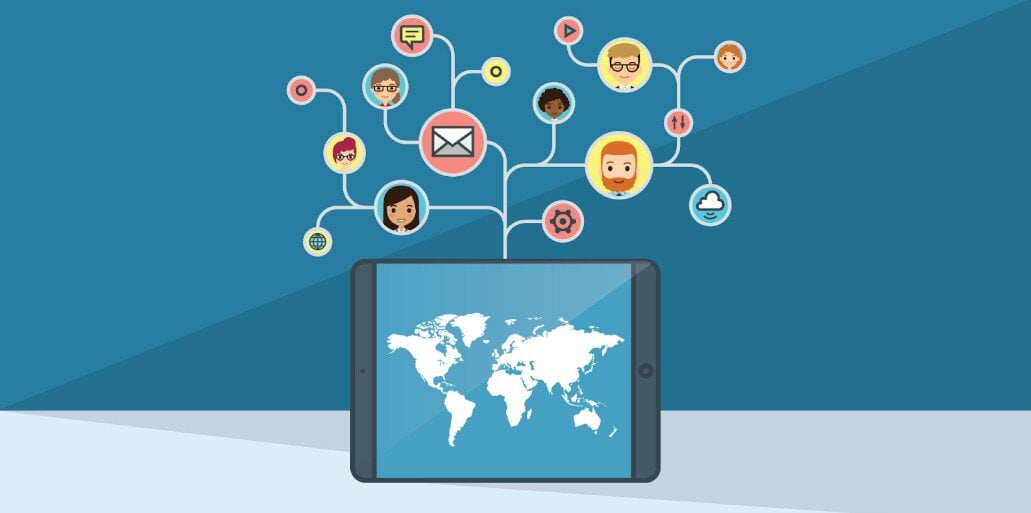The COVID-19 outbreak has forced companies into the most significant social experiment — the work-from-home approach. As you may know, the impact of coronavirus pandemic is widespread. Nearly every facet of life and every business has been affected. Moreover, COVID-19 has had a tremendous impact on the way how businesses function. With social distancing expected to stick around for months, thousands of companies had to go through the difficult transition of switching to remote work. For many companies, remote work is the norm or the primary working environment while for others it is a tremendous challenge. Every business owner or leader shifted to a work-from-home posture has found themselves in a new environment – a virtual one. This means that everything, from production pipelines to management and communication, has gone completely digital. Sounds interesting, right? So let’s find out what helps business leaders or owners to run their businesses remotely and successfully as well.
At the very beginning, it’s imperative to recognize types of businesses to be ready to make the transition to remote work. Companies can be broken into the following categories:
- knowledge-based: their products or services are knowledge-intensive;
- product- and location-based: they have products to be sold and a physical location where these products or services are sold.
However, all these types are eager to know how to establish their companies to be open all the time when there is a disruption. Here is a technology comes into play.
What digitalization means for your business
Digital transformation or digitalization is a process where companies rethink how they are using technologies to operate more efficiently or effectively. Moreover, it’s already transforming how and where work gets done. This doesn’t mean that companies use technology only to replicate an existing service in a digital form, it’s about “new” approaches and experimentation with new ideas. According to Gartner, digitalization is the use of digital technologies to change a business model and provide value-creating opportunities.
According to a recent survey, worldwide spending on digital transformation technologies such as hardware, software, and services will reach 2.1 trillion U.S. dollars by 2021. That means that businesses adjusting to a remote work environment either for the first time or for an extended period of time should take into account the right tech solutions to offer and support the work activities of their employees.
How to switch to the remote work environment
If you want your business to be an effective remote work environment, it’s imperative to consider the following areas when embracing the new normal:
1. Create a plan with minimal changes
It’s no secret that companies across a variety of industries — from logistics to real estate, finance to education — opt for video and audio conferencing, virtual desktops and other technologies used remotely in order not to put a business on hold. Employees can take such devices as laptops, desktops, monitors, keyboards, etc. from the office to their new home workspace. More importantly, business leader or owner should communicate a message that a company will work remotely, and every team should do their best to be successful and productive when using a new set of tools, new processes, and new methods at home. It’s essential that this is about re-thinking the new way of working, not just about working from home.
Essentials when setting up a remote workforce
Here we have provided some essential tips to follow if there is a necessity to urgently unlock the full potential of a remote workforce:
- Define remote policies and procedures: at the very start, you should create and establish remote policies and procedures outlining key processes and technologies, workflows, and activities.
- Change management: any changes in the workplace are a challenge. That’s why you should ensure both the technical and people aspects remain the key priority throughout this transition and get properly addressed. Not only can you provide onboarding and training opportunities for employees through essential FAQ documents, guides, and tutorial videos, but also you should plan them thoughtfully and approach with care.
- Identify a set of tools: it’s imperative to define tools and technologies that are highly flexible to meet your business needs. Only after making a choice can you assess how each tool will get applied, identify key metrics and KPIs, and ensure compatible application installment requirements are in place.
- Focus on cybersecurity: cyber attacks will cost the global economy an astounding 6 trillion U.S. dollars by 2021. That means you must follow cybersecurity best practices to identify vulnerabilities and ensure all sensitive data is highly protected. In addition to that, you should inform your team how to act when compromises do occur.
2. Align transition with business goals and budget
Every company needs a digital roadmap that is a standard practice to follow. Not only should you revisit it, but also create a strategy about how best to address short- and long-term goals. Make a revision of the company’s existing software, applications, and technologies and determine, based on the objectives earlier established, which of them need to be upgraded, automated, etc. If done properly, it helps you to match the technologies with the outcomes they deliver or the problems they solve. What’s more, you can communicate with a diverse range of experts or trusted advisors to prevent or stop wasting your two most precious resources such as time and money.
How to plan a budget for digital transformation
Budgeting for digital transformation requires a corporate rethink. Let’s find out how to plan your budget successfully:
- Involve everyone: this means that you should focus on a collaborative approach and be aware that every element of each core business process is included in your budget.
- Take into account unforeseen expenses: you may find out additional areas of business functions that should be accommodated in your digital transformation budget.
- Build a shared vision: it’s imperative to express your vision, communicate this to your teams, stakeholders, etc. and demonstrate your ideas and goals. Not only does it help you to create and cultivate a digital culture, but also it increases engagement.
- Demonstrate value: only by defining what work you’re going to realize can you inform how exactly digital transformation will deliver value for your business. For instance, higher revenues or automated paper-based business processes.
- Support changes: whether your budget fluid or not, it’s essential to adapt your budget to reality. for example, you can opt for two six-month budget plan that allows you to monitor potential business opportunities on the market and reinvest in more productive areas.
- Drive innovation: it’s imperative to keep your budget under control. Not only will it help you to invest in innovative solutions, but also you can capitalize on new trends and technology.
3. Centralize your systems
You can access cloud-based platforms such as SalesForce and Dropbox by using any device or any operating system. Not only do these cloud-based solutions help your team to focus on leveraging important files located in the cloud by accessing, editing, and collaborating on simultaneously, but also this will speed up the documents or files completion that requires multiple people or a team to complete. That’s why if you haven’t fully transitioned to cloud-based solutions, it’s high time. However, don’t try to do all of this immediately — provide your teams, managers, HRs, etc. with the right remote working tools that are obligatory in their remote work.
Technologies and tools essential for the remote environment
Below you can discover software and hardware solutions essential to choose wisely and leverage only such a solution which is necessary for the work to be done.
- Mobile hardware: employees should get such equipment as laptops, smartphones, etc. needed to perform their tasks from the company. In addition to that, teams need a fast, reliable and secure WiFi connection with a great internet package that is on the company’s budget. A bare minimum is a laptop, tablet, smartphone, internet access.
- Cybersecurity: it’s no secret that office environments are more secure while remote ones are more vulnerable to being compromised or hacked. That’s why it’s imperative to invest in adequate virtual networks, remote and online data network backups, multi-factor authentication, virtual environment infrastructure, etc.
- Online collaboration and communication solutions: in today’s digital world, teams work in a remote environment and use effective communication solutions – chat rooms, video conferencing, etc. for collaboration. These solutions built to simplify interaction among teams within the remote work environment Some of the most popular solutions are Slack, Skype, Mattermost, Rocket Chat, WebEx, Fuze, etc.
- Tools for performance and engagement: used to evaluate performance and help team leads, top managers, etc. to make daily decisions and adjustments without talking to your teammates face-to-face. Top popular tools are Trackstar, SAP, Glint, SuccessFactors.
- Project management solutions: built specifically to assist an individual employee or team to get their work organized effectively and manage projects and tasks efficiently. Popular solutions are Basecamp, Asana, Podio, Workzone, JIRA.
Also digitizing with ubiquitous tools and technologies that your teammates are familiar with is a great way to reduce costs and training time. Not only does it help you to organize a seamless information flow and simplify communication, but also you will power up your workflows with digital capabilities. That’s why make sure that the team members have reliable technologies/tools and understand how to use them.
4. Boost business continuity
New innovations and advancements in technology help to drive the remote workforce and make it more proficient in performing daily activities. Not only can teams function better, but also they get their tasks accomplished on the fly. Digitalization may result in workforce transformation leading the business towards advancements and building competitiveness in today’s dynamic environment. Companies moving fast to adopt digital transformation into their business can derive real benefits such as better engagement, increased profitability and improved retention when switching to the remote work. What’s more, they can steadily strengthen their sustainability and improve their brand value.
Benefits of Digitalization in your remote workforce
Only by using the right digital solutions can business leaders or owners derive the real benefits from the remote workforce provided. Let’s take a closer look below:
- Remote teams work conveniently from anywhere in the world when empowered with the right tech solutions. What’s more, they are more productive, have higher morale and high self-esteem.
- Team members equipped with tech solutions to better collaborate can produce more innovative ideas.
- Companies can keep all of their employees/teams connected and engaged through a variety of tools from group chats to 1:1 messaging.
- Companies that support remote environment can hire the top talents from anywhere.
Bottom line: Are you ready for the remote digital workplace?
Coronavirus outbreak has become detrimental to a great number of businesses. Dealing with the new reality of COVID-19, in which the workforce will become more digital, forced companies to turn to remote work with the help of digital transformation. Whether it involves new technology, cultural change, or other factors — it is risky and complicated. However, if done correctly, it can bring great results. Using the step highlighted above can help you to switch to the remote environment to be more productive. The most effective digital leaders need to make changes going within your organization through interaction that is imperative to stay competitive in the age of digital disruption. Whether your company has already transitioned to remote work during the COVID-19 or not, it’s high time to create a remote workforce that operates in a productive and secure manner. Not only does it help you to strengthen your business competitive edge, but also you will drive growth and revenue in the future.
Featured image: Source











What’s up everyone, it’s my first pay a quick visit at this web
site, and paragraph is actually fruitful designed for me, keep up posting these types of content.